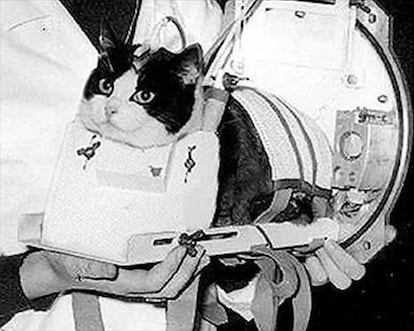Felicette: How France launched the first cat into space 60 years ago
While the world remembers Laika’s historic journey in 1957, it is less well known that a few years later, the first feline ventured into space as part of the French space program

Numerous animals have been sent into space since 1947 as part of experiments to test the survivability of spaceflight, predating human spaceflights. Today, some animals are still sent for various types of research. The first animals sent into space were fruit flies, aiming to explore the effects of radiation exposure at high altitudes. This was followed by a mission involving Albert II, a rhesus monkey, who became the first monkey, primate, and mammal in space on June 14, 1949, but tragically died on impact due to a parachute failure.
One of the most renowned missions in this field took place on November 3, 1957, when the second-ever orbiting spacecraft carried the first animal into orbit: Laika, a dog launched aboard the Soviet Sputnik 2 spacecraft. Laika didn’t survive the flight, and subsequent missions included other dogs and primates, such as Enos, the only chimpanzee to orbit the Earth in 1961.
In France, the national space program commenced in 1961, making it the third country to launch animals into space. On February 22, they sent a rat named Hector, equipped with implanted electrodes on his skull to monitor neurological activity. For their next mission, French scientists opted for a larger mammal and chose cats due to their existing neurological data. After training several cats, they selected a bicolor cat who was later named Félicette, and became the first cat in space 60 years ago.
A cat in space
In 1963, the Centre d’Enseignement et de Recherches de Médecine Aéronautique acquired 14 cats from a pet dealer for testing. All cats were female, chosen for their calmer temperament. They remained unnamed to avoid attachment from the scientists.
Surgically implanted permanent electrodes collected neurological data from the cats’ brains, and they underwent training, including confinement in their containers and spaceflight simulation with the high-G centrifuge chair and rocket noise.
Preparation for the launch began on October 8. On October 17, six cats were selected as candidates for the flight, with a “tuxedo” cat designated C 341 chosen for the launch due to her calm temperament and appropriate weight. Scientists attached electrodes to her forward left and right rear leg to monitor cardiac activity and glued electrodes to a foreleg for electrical impulse stimulation during the flight. A microphone on her chest monitored her breathing.

The launch occurred on October 18, 1963, using the Véronique AGI 47 sounding rocket from Vernon, Haute-Normandie. At 8:09 a.m., C 341 was launched from the Centre interarmées d’essais d’engins spéciaux site in Algeria. It was a suborbital flight lasting 13 minutes, reaching a height of 152 kilometers, with the cat experiencing five minutes of weightlessness. Following the flight, the C 341 was safely recovered.
When the flight’s biological data became public, C 341 was initially named “Félix,” but CERMA later changed it to the feminine “Félicette” as her official name. Despite surviving the trip, Félicette was euthanized two months after the launch for a necropsy to examine her brain.
Another cat was launched into space on October 24, but due to a rocket malfunction, it crashed, resulting in the cat’s death.
Nine other cats acquired for the project were euthanized at the program’s end, except for one whose health deteriorated after electrode surgery. Scientists removed the electrodes and adopted her as their mascot, naming her Scoubidou, given her scoubidou braid around her neck.

Some believe that Félicette’s flight was less popular at the time due to photos of her with electrodes implanted on her skull and the emerging animal rights movement. Despite this, Félicette’s mission played a role in establishing France’s presence in the space race. To honor her contribution to science, a campaign led by Matthey Serge Guy in 2017 resulted in the unveiling of a 1.5-meter tall bronze statue designed by sculptor Gill Parker at the International Space University in France on December 18, 2019. The statue depicts the cat perched atop planet Earth, gazing at the sky.
Sign up for our weekly newsletter to get more English-language news coverage from EL PAÍS USA Edition
Tu suscripción se está usando en otro dispositivo
¿Quieres añadir otro usuario a tu suscripción?
Si continúas leyendo en este dispositivo, no se podrá leer en el otro.
FlechaTu suscripción se está usando en otro dispositivo y solo puedes acceder a EL PAÍS desde un dispositivo a la vez.
Si quieres compartir tu cuenta, cambia tu suscripción a la modalidad Premium, así podrás añadir otro usuario. Cada uno accederá con su propia cuenta de email, lo que os permitirá personalizar vuestra experiencia en EL PAÍS.
¿Tienes una suscripción de empresa? Accede aquí para contratar más cuentas.
En el caso de no saber quién está usando tu cuenta, te recomendamos cambiar tu contraseña aquí.
Si decides continuar compartiendo tu cuenta, este mensaje se mostrará en tu dispositivo y en el de la otra persona que está usando tu cuenta de forma indefinida, afectando a tu experiencia de lectura. Puedes consultar aquí los términos y condiciones de la suscripción digital.
More information
Archived In
Últimas noticias
Most viewed
- David King, chemist: ‘There are scientists studying how to cool the planet; nobody should stop these experiments from happening’
- Reinhard Genzel, Nobel laureate in physics: ‘One-minute videos will never give you the truth’
- Mexico completes its trade shift with the entry into force of tariffs on China and countries without trade agreements
- Oona Chaplin: ‘I told James Cameron that I was living in a treehouse and starting a permaculture project with a friend’
- Sinaloa Cartel war is taking its toll on Los Chapitos











































